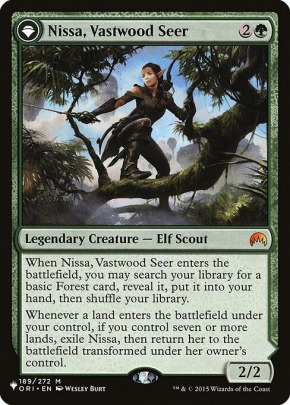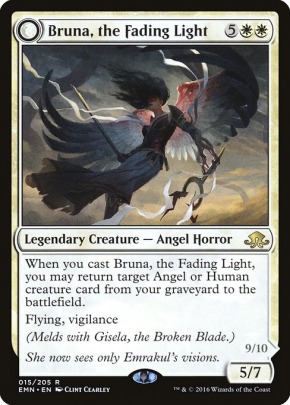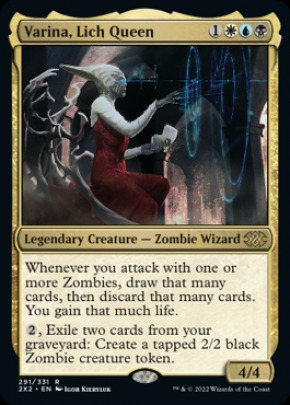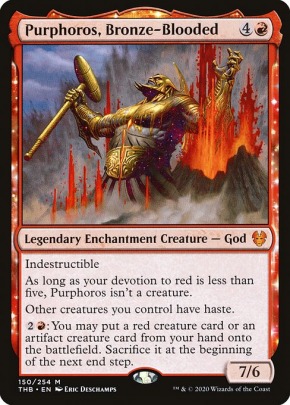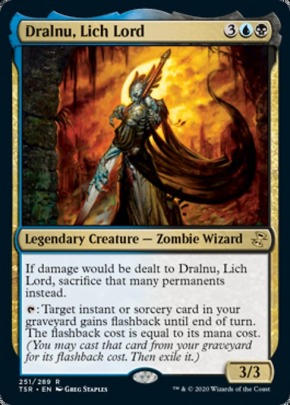One other small preamble: I am not breaking new ground here at all. Most active Nexus members know and practice these principles, many better than I do, and I don't presume to be teaching them anything. That said, there are lots of folks out there in lurker land and/or new to commander who stand to benefit from this information being synthesized into a single post, and this is my attempt to help them out.
One of the first rules of Magic that all players learn is that you get to play one land from your hand on each of your turns, and thus the game scales allowing for more expensive and powerful spells to be cast the longer it continues. Once a player has been bitten by the Magic bug and starts reading articles, watching videos, lurking in forums, and scouring online decklists, they tend to realize that success in Magic is usually achieved through bypassing or warping basic gameplay rules or doing something "unfair". Taking extra turns. "Cheating" a creature into play. Drawing more than one card per turn, so on and so forth. Commander as a format is no exception and often represents the most dramatic alterations of basic Magic gameplay.
This is certainly true with regard to mana production since Commander is the Sol Ring format and "ramp" is everywhere. So much so that players often err on the side of ramping rather than making their land drops consistently. @pokken deals with the pros and cons of such an approach in First, Hit Your Land Drops. Assuming you've read that and first adopted a mindset that prioritizes consistently playing a land every turn in games longer than 3-4 turns, you can now consider ramp without biasing your deck building choices as much.
Defining Ramp
Now, for the uninitiated reader wondering: what is ramp? Simply put, ramp is any in-game effect which allows a player to make mana beyond what they would normally be able to when playing a single basic land on each of their turns. For example: You tap your land for one mana to play Sol Ring, which can now immediately tap for two mana. Tada! You have ramped by turning your one mana into two, and you can do it on the first turn of the game.

There are tons of cards that can ramp just by themselves or with minimal support. Ancient Tomb is ramp similar to Sol Ring, but on a land. Myriad Landscape is too, but it takes longer. Llanowar Elves is ramp on a creature, Solemn Simulacrum is a different kind of ramp on a creature, and Azusa, Lost but Seeking is yet another type of ramp on a creature. How one decides which kind of ramp cards and how many to include in a deck is key to it functioning well rather than folding like a cheap suit against more tuned decks. Evaluating ramp cards and choosing which to play in your deck should align with at least four key considerations.
Much of what follows is generalized card evaluation since it is theoretical and there's no deck or commander to reference, but the broad principles are the key, not the specific minutiae.
Cost
First consider the cost of the ramp spell you are evaluating, and that is not limited to its mana cost. For example, Ancient Tomb may not cost you any mana, but it costs you life and a land slot in your deck that could be making colored mana. You must weigh those costs against the benefits received and whether the trade-off is a net gain or loss for your deck. Mono colored with a life gain theme? Get on in there Ancient Tomb. 5-color goodstuff with very few generic mana costs? Better sit this one out AT. (Eating into your budget is also a real cost, albeit outside of the game, so writing a card like AT off straight away might be simple. It's why this post won't be tackling Mana Crypt, Mana Vault, Mox Diamond, etc.)
How about that spectacular Sol Ring of yours? It costs 1 mana, but immediately makes 2, so it's even better than free in terms of net mana. However, it does cost a card slot in your deck and doesn't make colored mana. Those are very real costs, as anyone who ever badly needed a colored source or removal spell but drew Sol Ring instead can tell you. However, those costs are massively outweighed by the benefits for most decks and that's why Sol Ring is everywhere in this format.
Now take Gilded Lotus as an example. It's Converted Mana Cost (CMC) is 5, but it can immediately tap for 3, which would make the actual cost on the turn it was played 2 mana. Seems rough in comparison to Sol Ring eh? Well, at least it makes colored mana, right?
Ahhhh, but wait. The turn it was played is not the whole story, now is it? That leads to the next consideration.
Return On Investment
Return on investment (ROI) is directly related to cost, as you'll see with the others as well (each factor is distinct in some sense but also inseperable from the others). ROI by definition requires that you first tally up your cost. So looking at Sol Ring and Gilded Lotus you can see that the former had an ROI of 100% the turn it was played by recouping the one mana spent and then profiting you one additional mana. Lotus, on the other hand had no ROI and was even a net loss.
Now continue this experiment for a handful of turns:
Sol Ring cost 1 and made 4 mana, a 300% ROI
Gilded Lotus cost 5 and made 6 mana, a 20% ROI
3 turns:
Sol Ring cost 1 and made 6 mana, a 500% ROI
Gilded Lotus cost 5 and made 9 mana, a 80% ROI
4 turns:
Sol Ring cost 1 and made 8 mana, a 700% ROI
Gilded Lotus cost 5 and made 12 mana, a 140% ROI
5 turns:
Sol Ring cost 1 and made 10 mana, a 900% ROI
Gilded Lotus cost 5 and made 15 mana, a 200% ROI

Sol Ring's efficient ROI is more along the lines of how we typically think of investing. Start saving for retirement early, buy low sell high, compound interest, etc. This kind of ramp is great. If not interfered with, the player who plays an early Sol Ring, Birds of Paradise, Rampant Growth, Arcane Signet, etc. will incrementally produce a lot more mana than the player who didn't, and, generally speaking, spending the most mana will often result in victory.
However, Magic is not your 401k or Roth IRA, and sometimes liquidity and cash in hand is king. For example, on turn 5 player A casts Sol Ring but player B casts Gilded Lotus. Now on turn 6 player A is a mana short of their Rise of the Dark Realms while player B happily casts their Clone Legion. Frankly, comparing most ramp to Sol Ring is silly because Sol Ring and the other cheap, fast mana rocks like crypt/vault are just so darn good. This is just a hypothetical example to illustrate that a higher mana-per-turn output sooner can make a huge difference without primarily being an incremental advantage. This also really blurs the line with the next category, speed, but for now the point of emphasis is that an immediate ROI and long term ROI are two different things that are both desirable in Magic for different reasons.
If the concept is still fuzzy, an example that might help you see it more clearly is a turn 5 Cultivate vs a turn 5 Gilded Lotus. In the first case, you'll untap for turn 6 and have 7 mana after your land drop. In the latter, you'll untap and have 9 mana after your land drop.
One last helpful way to see this more explosive side of ramp ROI is to think of it in terms of your entire mana pool's rate of expansion. A turn 5 Lotus into Worn Powerstone doubles your mana production for the next turn before you even play a land, and in quantities that are potentially game ending.
In addition to distinguishing between incrementally efficient ROI and explosive ROI, synergy is also a vital factor to consider when weighing your ramp options' ROI. In a Isochron Scepter/Dramatic Reversal deck for example, Gilded Lotus is infinite colored mana and infinite untaps while Sol Ring is just infinite untaps. In a deck with Ghostly Flicker/Archaeomancer, Lotus is infinite storm and creature ETBs while Sol Ring is not.
Examples with big fat rocks like Gilded Lotus, Thran Dynamo, Dreamstone Hedron and Chromatic Orrery show the power of explosive ramp ROI, but that might more accurately be referred to as an ROI calculation over a duration of time, whether compressed or expanded. Which leads directly to the next major variable in evaluation of ramp spells.
Speed
The speed of your deck's mana ramp is the quality that defines how rapidly your ramp spells deliver additional mana to you and through what method: on an installment plan each turn, on one turn all at once, or somewhere in between. Another way to phrase it might be that Cultivate potentially gets you extra mana production faster, meaning earlier in the game, while Gilded Lotus or other big rocks are slow to arrive on the battlefield but potentially get you more mana for a single explosive turn. Both are "fast", but the nature of their speed is different. The takeaway is that "faster" ramp is better, but you can have different definitions of "fast" depending on what your deck is trying to do.
The "installment plan" speed of ramp spells typically take the form of a Rampant Growth effect. You get to search your library for a land (usually a basic) and put it into play tapped. That land will now make you one additional mana per turn for the remainder of the game, which can make a big difference.
Previous examples have already established how mana rocks can exist in either the "installment plan" or "a bunch at once" categories of mana ramp speed. A good example that can legally go in any deck and also lives fairly close to the center of the spectrum between the two extremes is Walking Atlas. It can give you an extra land that is ready to tap for mana as soon as turn 3, just like Rampant Growth, but it also has the potential to snowball and compound the extra mana "installment plan" by giving you an additional land several turns in a row (up to 8 mana worth of production by turn 5), but you will likely need some card draw or land tutoring effects to support it. In an average case it will likely only net you 1-3 extra lands in a game, which is a fine ROI, but it brings up a new factor which is when it gets played. If you play Walking Atlas on turn 2 it's excellent. Drawing it on turn 12 though, well... that sucks, and it shows once more that ramp spells have costs outside of their CMCs, their ROI is subject to a number of variables, and there are different kinds of "speed".
Creatures that tap to create the mana themselves (aka "Mana Dorks") can also reach across the speed spectrum. In a deck with a creature based strategy, Llanowar Elves is a quick way to get an extra mana per turn, and the effect snowballs with more of the same type of spell. Turn 1 Llanowar Elves can lead to Turn 2 Arbor Elf + Elvish Mystic which leads to a Gilded Lotus worth of mana value on Turn 3. That's fast, but the example only worked with multiple ramp spells. Perhaps a more typical Turn 1 Llanowar Elves with no follow up ramp on Turn 2 is still fast in the sense that it got you extra mana early in the game, but not fast in the sense that you couldn't fire off a 6 mana spell on turn 3. There are some especially fast dorks though, especially if you can flash them out or give them haste. Elvish Archdruid, Priest of Titania, Magus of the Coffers, Kydele, Chosen of Kruphix, Gyre Sage, or Marwyn, the Nurturer can represent a lot of fast mana in the right deck and Elvish Guidance, Leyline of Abundance, and Song of Freyalise play the dork game without being dorks themselves.
A vastly underrated type of ramp spells are the various cost reduction effects available. The cycle of color discounting medallions, the creature discounting Amonkhet monuments, and creatures like Goblin Electromancer, Foundry Inspector, Danitha Capashen, Paragon, Transcendent Envoy, Etherium Sculptor, and Cunning Nightbonder can functionally "produce" more than one mana per turn like an additional land in play would depending on how your deck is constructed. Get one out early for the savings on a turn by turn basis, or get one out after drawing a full grip and dump your hand thanks to the discount functionally giving you a fast burst of mana.
Moving on from the "installment plan" and then past the middle-of-the-road "flexibly fast" ramp you arrive at the ramp spells which are firmly in the "all at once" camp of mana acceleration speed. The poster children for this ramp speed are ritual effects, mana doublers, and bonkers-tier lands.
The rituals are named after cards like Dark Ritual and Pyretic Ritual. For the commander format, perhaps the fastest one is Mana Geyser, which can make a whole lot of mana with three opponents ramping out extra lands themselves and tapping out for huge spells. Then there's the more situational but potentially more powerful Brightstone Ritual, Songs of the Damned, Battle Hymn, and Inner Fire. These tend to go really well with copy effects like Narset's Reversal, Bonus Round, or Increasing Vengeance.
Mana doublers are exactly what they sound like: cards that double your output of mana. Caged Sun or High Tide in a mono colored deck, Mirari's Wake, Regal Behemoth, or Heartbeat of Spring and Mana Flare. Careful though. If you didn't catch it, a big cost to the latter two are the fact that they have the same effect for your opponents. Green has recently been blessed with a mana tripler in Nyxbloom Ancient, but there's a big up front cost to balance it out.
Mass untap effects have close to the same effect, though usually as a one off or in spurts with timing restrictions. Turnabout, Seedborn Muse Unwinding Clock in a deck full of rocks, Mobilize, Quest for Renewal, and Murkfiend Liege in a deck full of dorks, and so on. Combine untap effects with the mega dorks and/or mana multipliers and you are really in the fast mana money.
Then there's the insanity level lands. Nykthos, Shrine to Nyx, Cabal Coffers, Serra's Sanctum, and Gaea's Cradle/Growing Rites of Itlimoc // Itlimoc, Cradle of the Sun are some of the big nasties. Lots of mana, very fast. Most of these are legendary, and for good reason, but Cabal Coffers can be copied with a Mirage Mirror or Thespian's Stage for stupid amounts of mana. Throw an Urborg, Tomb of Yawgmoth in the mix for real shenanigans. All of these, including the legendaries, can and should be combined with untap effects for fast burst of huge mana.
Speed isn't everything though, and you are, after all, playing against opponents who don't want you to win and will actively try to mess with your plans. Thus, there's even more to consider.
Resiliency
You cast a tragic last glance at your board full of mana rocks as your opponent says, "I cast Vandalblast for its overload cost".
You wonder what you'll do with that grip of 8+ cmc spells now that the Elesh Norn, Grand Cenobite has hit the battlefield and none of your dorks lived to tell the tale.
You were ready to combo out before Steve responded to your Mana Geyser with a Counterspell. Nobody likes Steve anyway.
Alas, these tragic accounts are not mere fables, but true accounts of ramp gone wrong. Such horrors are even commonplace in Commander metas worldwide. What can one do in the face of such reckless mana hate?
Consider the lowly Wayfarer's Bauble. It only costs you a single generic mana, almost certainly will not be targeted by countermagic or removal, can be sacrificed at instant speed, and puts an additional basic land into play for you that isn't worth your opponent's Strip Mine. That, ladies and germs, is some resilient mana ramp that is legal in any deck.
Legion's Landing // Adanto, the First Fort is dirt cheap, fairly easy to flip into Adanto, the First Fort, dodges most board wipes, and usually won't draw out your opponent's spot removal. Resilient ramp.
Colorless cards that flip into lands relatively easy are decently resilient options too: Treasure Map // Treasure Cove, Dowsing Dagger // Lost Vale, and Thaumatic Compass // Spires of Orazca deserve a lot more play. Even a wackier option like Golden Guardian // Gold-Forge Garrison can be a high synergy resilient ramp option in many decks.
Back to the earlier examples of Rampant Growth and Cultivate you have resilient options only vulnerable to countermagic. Likewise with Solemn Simulacrum since you really shouldn't feel bad if an opponent kills it after it ETBs. Rituals and single use untap like Turnabout are only vulnerable to counters as well, but they are waaaaay more likely to draw a counter out.
If you haven't picked up the thread here, additional lands onto the battlefield are the most resilient way to ramp up your mana production.
There are many ways to do it, some safer and/or faster and/or cheaper than others. Explore, Explorer's Scope, Sword of the Animist, Cartographer's Hawk, Walking Atlas, Explosive Vegetation, and similar cards exist in droves to give you a second land per turn. It's usually a basic though, so these become more difficult to include in 4 or 5 color decks.
The resiliency of lands are also why those nonsense-tier lands mentioned previously are so good. Sure they can Strip Mine your Nykthos, Shrine to Nyx, but not until you get at least one activation.
Mana rocks are slightly more resilient than dorks since fewer board wipes affect them, and enchantment ramp like Overgrowth or Khalni Heart Expedition are a smidge more resilient than rocks since artifact removal tends to be more prevalent than enchantment removal.
Well, that's a whole lot of words to say: choosing a collection of the best ramp spells for a deck is far more complicated than just jamming in Sol Ring, all the on color signets and talismans, a busted land, and 2-3 Rampant Growths.
If this post only makes one point it should be: be picky about your ramp cards, which should first and foremost synergize with your commander and your deck as a whole.
Some examples should clarify.
Case Studies
If you're building Thada Adel, Acquisitor, then Dowsing Dagger // Lost Vale is a very strong inclusion since it naturally curves out with Thada on turn 3 then dagger + equip and attack on turn 4. Even later in the game it's fine since you've likely donated an island via Vedalken Plotter or some other means and will be able to connect easily enough with islandwalk. You're monoblue, so Nykthos, Shrine to Nyx, High Tide and Turnabout are great for huge bursts of fast mana, and Narset's Reversal gives you a way to copy either (or an opponent's Cultivate). 2-3 cmc rocks don't make a ton of sense without some added shenanigans in the deck since they don't help you get Thada out quicker and your gameplan is likely to include stealing opponents' rocks with Thada. Thran Dynamo has quite a bit of combo potential in mono blue. Sword of the Animist goes well with Thada's typical equipment focus and gives a solid resilient and repeatable source of ramp. A couple more resilient ramp cards thrown in the mix and a solid first pass at a Thada ramp package might look like this:
On the other hand, ramping with Mayael the Anima will be a whole different story. You're in green, want to get to six mana ASAP and need three colors of mana along the way to cast Mayael first. Rampant Growth, Cultivate, and Kodama's Reach fix your colors, ramp you, and the latter two keep the land drops coming. Sacellum Godspeaker is a unique dork for this deck, and Gyre Sage is a dork that gets better as your fatties ETB. Both go well with any untap shenanigans like Mobilize or especially Seedborn Muse you'll be wanting to play for Mayael's sake anyway. It's hard to argue against including Oracle of Mul Daya here since you get both extra lands and a peek at the top card before activating Mayael. Elvish Harbinger can get oracle or either dork, plus it ramps and fixes by itself. You'll want to hard cast some fatties from your hand too, and Mana Geyser can get you there. Rocks aren't too appealing for Mayael, but Chromatic Lantern and Chromatic Orrery in particular are excellent fixing to help activate her multiple times per turn, and Wayfarer's Bauble is cheap, resilient fixing and ramp. Treasure Map // Treasure Cove is good early or late game for Mayael thanks to the scrying and fixing/card draw that come with the ramp. Finally, there are several big creatures Mayael could hit that ramp, chief among them Wayward Swordtooth, Regal Behemoth, and Nyxbloom Ancient. So a start for Mayael ramp could be something like this:
I hope all that helped at least one up and coming Commander player to build better decks moving forward. If you want the main points condensed, here they are:
- Sol Ring and other cheap, fast mana rocks are real stinking good, but don't just assume they are all your deck needs or even the best options.
- You must consider multiple variables with your ramp pieces and should include a variety in your deck that include options which are either 1) cheap 2) high risk, high reward 3) fast/sudden/explosive or 4) resilient. There will certainly be overlap, but be sure you have some of each.
- More decks should run Wayfarer's Bauble.
- Include ramp that synergizes with your commander, its CMC, and your deck's needs and desired strategies.

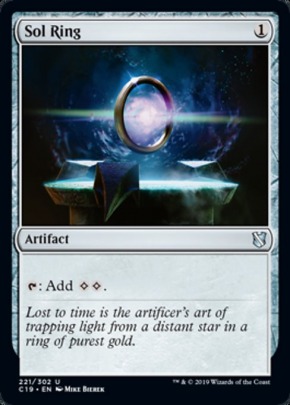

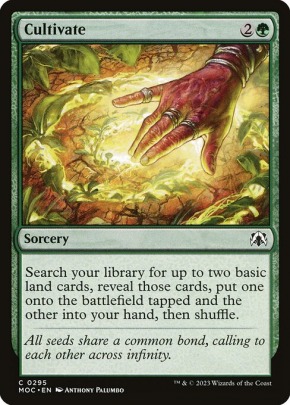
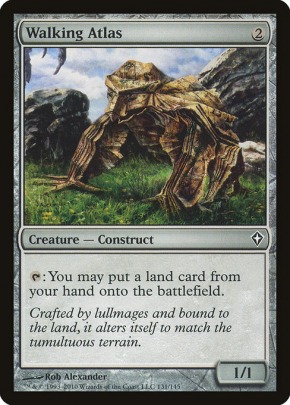
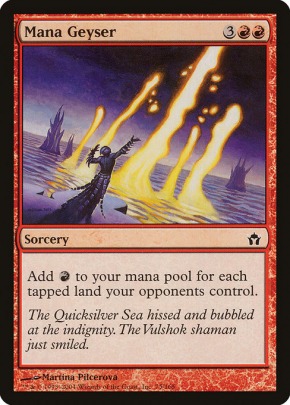

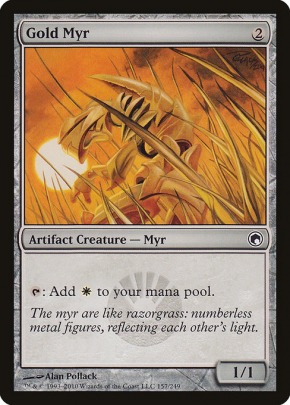



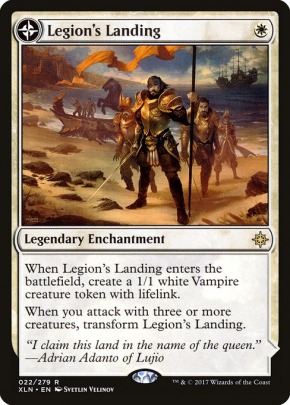
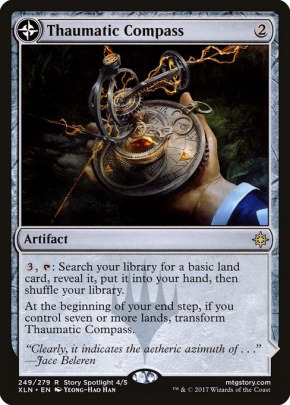

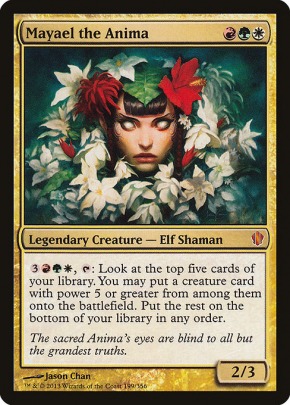
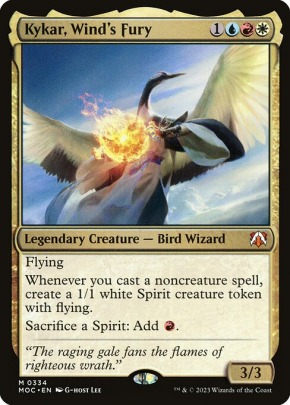
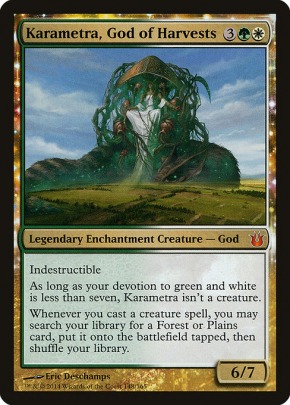
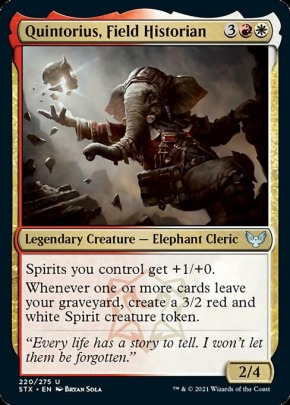
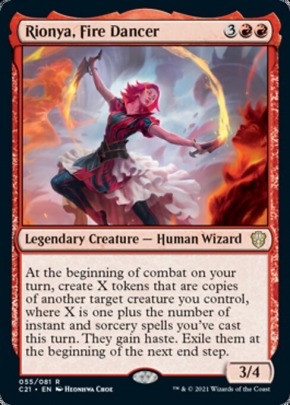
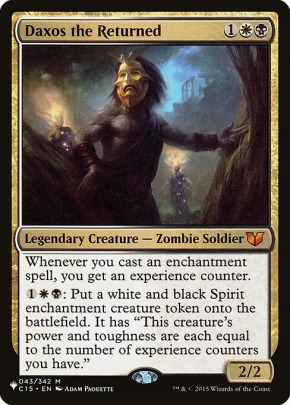



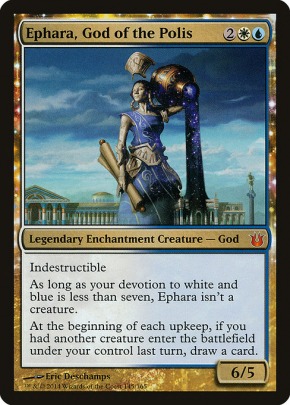



 Zacama
Zacama


